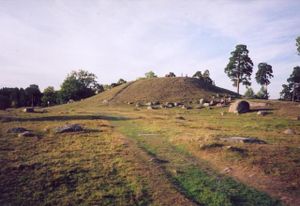- Håga Kurgan
-
The Håga Kurgan (Hågahögen) or King Björn's Mound (Kung Björns hög) is a large Nordic Bronze Age kurgan in the western outskirts of Uppsala, Sweden. It is one of the most magnificent remains from the Nordic Bronze Age.
Contents
Hågahögen
Hågahögen mound is approximately 7 metres high and 45 metres across and it was constructed ca 1000 B.C. by the shore of a narrow inlet of the sea (the land has been continually rising since the Ice Age, see land elevation). It was constructed of turfs that had been laid on top of a cairn which was built on top of a wooden chamber containing a hollow oak coffin with the cremated remains of a short man. During the burial there had probably been human sacrifice, the evidence for which is human bones from which the marrow had been removed.
The coffin contained rich unburnt bronze objects such as a Bronze age sword, a razor, two brooches, a number of thickly gilded buttons, two pincers and various other bronze objects. They may all come from the same workshop in Zealand.
The mound was excavated 1902–1903 by Oscar Almgren together with the future king Gustaf VI Adolf. Only minor excavations have been done in the Bronze Age settlement but the area contains several house foundations in stone. The findings from Hågahögen were stored in The Swedish Museum of National Antiquities (Historiska museet) on Narvavägen in Östermalm in Stockholm.
In February 1986 a theft was committed in the Swedish Museum of National Antiquities. One of the Museum's more important and attractive art objects, the Bronze Age spectacle-shaped gilt brooch found in 1902—03 at Hågahögen was stolen. Parts of it were found outside the Museum's main entrance some months later after snow had melted.[1]
Etymology
The place name Håga means the "tall mound" and it is mentioned in the Hervarar saga as Haugi (from the Old Norse haugr meaning knoll, mound or a hill). The name Björn's mound is from the Swedish king Björn at Haugi (Björn at the mound) who used to live at the royal estate (see Uppsala öd) of Håga as his brother and co-king Anund Uppsale resided at Old Uppsala. The connection between the king and the mound was later reversed and the mound was named after the king, like the king had previously received his cognomen after the mound. Coordinates: 59°50′N 17°35′E / 59.833°N 17.583°E
See also
References
Other sources
- Almgren, O. (1905) Kung Björns hög och andra fornlämningar vid Håga (KVHAA Monografi nr 1. Stockholm)
External links
Categories:- Nordic Bronze Age
- Uppsala
- Archaeological sites in Sweden
- Kurgans
Wikimedia Foundation. 2010.


